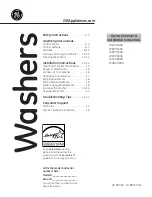
71
Place the containers close to the appliance.
IMPORTANT
: Do not mix different detergents or rinse aids as they could crystallise and damage the
dispensers. Whenever the type of detergent or rinse aid is changed, it is ABSOLUTELY ESSENTIAL to
clean and bleed the dispenser and its hoses, by placing the detergent/rinse aid pipe in water for several
cycles.
If the rinse aid or detergent is changed, the settings should be adjusted accordingly by qualified personnel.
RINSE AID
The machine is fitted with a rinse aid dispenser as standard. This automatically dispenses the rinse aid in
the machine boiler.
Use liquid rinse aid especially designed for use with industrial dishwashers and which is non-foam
forming at high temperatures.
Rinse aid is necessary to correctly disperse and drain the water over the dishes in order to avoid stains and
to speed up the drying process.
Scratched dishes and the formation of foam in the wash solution are usually an indication of excess rinse
aid. Dishes with too many water drops or which are slow to dry are usually a sign of insufficient rinse aid.
DETERGENT
The machine may come fitted as standard with a detergent dispenser. If this is not the case, it can be
installed subsequently. Please ask your dealer or the manufacturer.
Use liquid detergent especially designed for use with industrial dishwashers and which is non-foam
forming at high temperatures.
Detergents designed for domestic use should not be used under any
circumstances.
Detergent is necessary to correctly clean the dirt and food remains from the dishes.
If the appliance is not fitted with a detergent dispenser, we recommend you install one. Otherwise it will be
necessary to dispense the detergent manually by pouring it into the centre of the tub, taking care to correctly
dissolve the detergent (not recommended as this does not guarantee optimum conditions for washing and
cleaning).
5.7
Preparation and switching on the machine
Before switching on the machine:
✓
Check that the wash/rinsing arms are correctly positioned
and fastened and rotate correctly.
✓
The corresponding filters must be clean and in place.
✓
The overflow should be mounted in place. Press until it is
firmly inserted.
(See figure).
✓
Check and maintain the levels of detergent and rinse aid
in the containers to ensure they last throughout the
working day.
Make sure that the weight and filter are
correctly fitted on the tubes and that the tubes are
correctly immersed in the correct containers.
✓
Open the water mains tap and check that there is water.
Switch on the mains power switch.
Close the hood of the machine.
To switch on the machine, just set the cycle selector switch to
SELECT
(
Fig. 7
) in any position of the Wash
cycle (
C1, C2, C3
) (
Fig. 7
), and the
ON LIGHT
will come on (
Fig. 7
).
If the machine does not have a cycle selector switch, just press
ON/OFF
(
Fig. 8 & 9
) for 2 seconds, and
the
ON LIGHT
will come on (
Fig. 8 & 9
).
In model
“C”
, in addition to the
ON LIGHT
(
Fig. 9
).the
DISPLAY
is also activated (
Fig. 9
) indicating that
the machine is filling and the
START
button (
Fig. 9
) lights up in red.
WARNING: DO NOT INSERT HANDS AND/OR TOUCH THE INTERNAL PARTS OF THE TANK WHILE
THE MACHINE IS OPERATING AND WAIT 10 MINUTES AFTER THE WASH TANK
HAS DRAINED.
Filter
Overflow
Wash/rinsing
arms:
Summary of Contents for AD-125
Page 14: ...14 MOD A CO 142 MOD B COP 144...
Page 15: ...15 MOD C...
















































